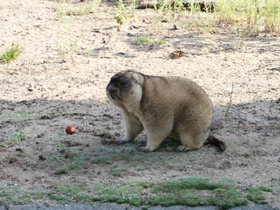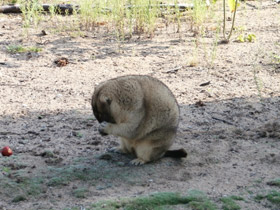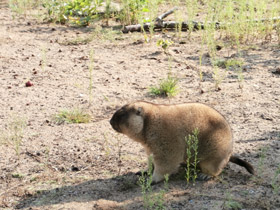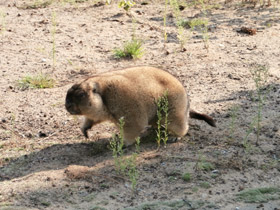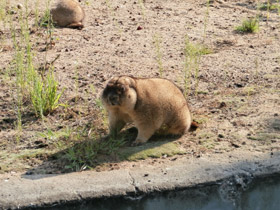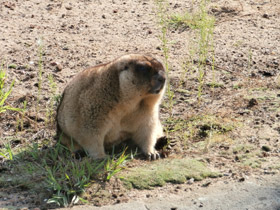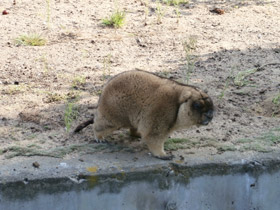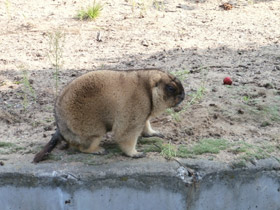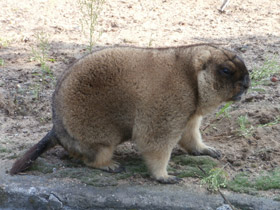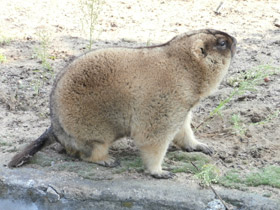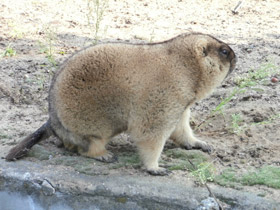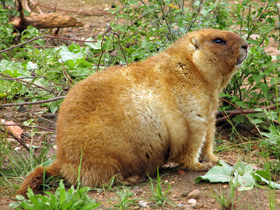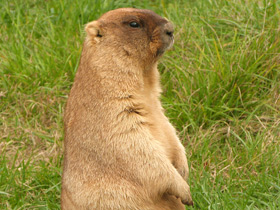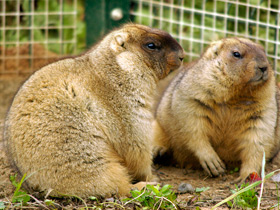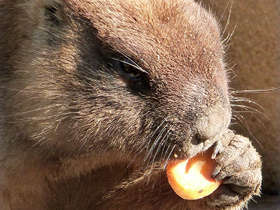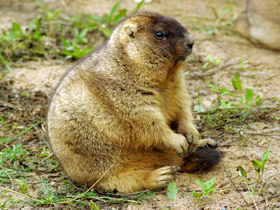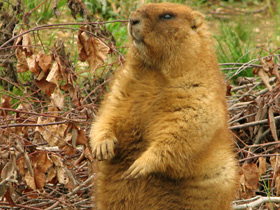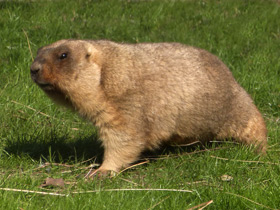The steppe marmot, or bobak marmot Marmota bobak
In the past, the steppe marmot was distributed along entire steppe zone and part of the forest zone, from Hungary to the Irtysh River; however, ploughing of steppes and conversion to arable land significantly reduced the range of bobak marmot in the European steppes. Currently the range of the bobak marmot is fragmented into isolated populations in unused land and protected areas in Ukraine, south of Russia, steppes of Low Volga, the Southern Urals, and North Kazakhstan. The bobak marmot is a typical inhabitant of open lowland, mixed grass, arid, and wormwood steppes. Where marmot habitats have been conversed to arable lands, bobak marmots move to closest newly-ploughed virgin lands or to unarable lands, such as fallow lands, slopes of low hills, shallow ravines, field boundaries, pastures, and even country roadsides. Suitable habitats now comprise insignificant proportion of arable lands. Bobak marmots usually do not live in crops or vegetable fields, staying in such places for short periods, when other habitats are not available.
The bobak marmot is one of the largest representatives of the squirrel family; its body length ranges between 50 and 70 cm, with body weight of the males reaching 10 kg. The bobak marmot has a stout body, short, strong legs, large claws, and large, flattened head supported by the short neck. Bobak marmot can be easily distinguished from other marmot species by its short tail measuring no more than 15 cm, and straw-coloured pelage.
Bobak marmots live in large, stable colonies and build burrows of different complexity. Their temporary burrows are small and short; they have one entrance and do not include nesting chamber. These burrows are used as shelters where marmots hide and sometimes sleep. Feeding territory may contain up to ten temporary burrows. Permanent burrows have more complex structure and include both winter and summer burrows. Summer burrows consist of the complicated system of passages; they have 6 to 15 exits. Main passage has a number of pockets which are used as toilets. Nesting chamber with the volume of 0.5-0.8 m³ is built at the depth of 2-3 m; marmots usually bring in a lot of dry grass and plant roots. Wintering (hibernation) chambers are simpler but their nesting chambers are located in deeper (unfreezing) soil horizons, up to 5-7 meters under the ground. Total length of all the passages of the permanent burrow may reach 57-63 meters. Most complex burrows have several chambers of different sizes and a few floors. While building a burrow, marmots throw up onto the ground up to ten cubic meters of soil, creating large mounds (dirt “porches”). Usually marmots’ mounds stand out against the black earth due to their lighter colour; the soil in the mounds is shallower and saturated with oxygen and mineral substances from marmot faeces. The mound may be as high as 40 to 100 cm and as wide as 3-10 meters in diameter. The mound has a special observation site that is used by the marmots for watching for predators. The rest of the mound surface gradually becomes grown over by wild plants (such as sagebrush, wheatgrass, and marsh-beet). Dirt porches occupy up to 10% of the territories densely populated by bobak marmots, creating rippled local landscapes.
Bobak marmot diet consists of lush, soft steppe grasses. Favourite plants include wild oats, wheatgrass, chicory, clover, and lesser bindweed. Food preferences differ depending on the season; thus, in early spring bobak marmots prefer overwintered roots and bulbs, while in summer the animals mainly eat sprouts of crops and wild grasses, as well as flowers. In late summer, when steppe plants are burned down, bobak marmots move further from their burrows in search of humid areas with lush grasses. Mature fruits and seeds are not digested in the marmot stomach and are disseminated in faeces. Before winter, in preparation for hibernation the bobak marmot consumes 1 to 1.5 kg of plant mass per day. The bobak marmot can also eats locusts, molluscs, caterpillars, and ant pupae, consuming them with grass. The bobak marmot does not store food for winter. These animals do not drink water, relying on the liquid contained in plants or licking up morning dew.
By the end of summer, marmots store up to 800-1200 grams of fat; this is equivalent to 20-25% of their body mass. In late August and September, the animals congregate in hibernation burrows, forming groups of 2-5 to 20-25 individuals. Marmots plug all entrances with a mixture of dirt, faeces, and small stones and start hibernating. Hibernation lasts 6 to 8 months. The temperature in winter chambers does not drop under 0°C even in coldest times. During hibernation many of the marmot body functions decrease; body temperature drops from 36-380C to 4.6-7.60C, respiratory rate decreases from normal 20-24 breathes per minute to 2-3 breathes per minute, and heart rate slows down to 3-15 beats per minute (instead of normal 88-140 beats per minute). Marmots do not eat and hardly move in winter, surviving due to their fat stores. However, their expenditures of energy during hibernation are very low and when emerging from hibernation burrows in spring time, bobak marmots may look quite plump, with 100 to 200 g of fat still being stored in the body.
Bobak marmots generally emerge from their burrows in late February or early March. After some period of intense feeding, they start repairing old temporary burrows or building new ones; at a later stage they would renovate and expend their permanent burrows. They are most active in early morning when they wake up and start foraging. While above the ground, marmots maintain visual (upright postures) and acoustic (roll calls, alarm signals) contacts. Usually two marmots stand sentinels while other members of the colony are foraging. The sense of hearing in marmots is not as developed as their sight therefore they react to the sight of marmots running to their burrow rather than to alarm whistles. In the daytime, bobak marmots rest in their burrows and come on the ground by late afternoon. They spend 12 to 16 hours a day above the ground. Bobak marmots move with intermittent runs; sometimes they stop and freeze on spot. When fleeing from approaching predator, they run fairly fast, reaching a speed of 12-15 km per hour on flat sites, and trying to hide in a closest burrow.
Mating season in bobak marmots occurs in March and April. Gestation lasts from 30 to 35 days and results in the birth of 3-6 pups. Newborn marmots are hairless and blind; they have a body length of 9-11 cm and weigh 30 to 40 grams (which comprises about 1% of the body weight of the mother). The eyes of the pups open only on the 23-d day of their life. During the period of gestation and nursing the male stays in a different burrow. The female nurses her pups for 50 days though they start eating grass at the age of 40 days. Marmot family was thought to consist of adult pair of animals and their two litters born in the last two years, but recent studies showed that some of the offspring born in the current year leave their family and get adopted by one of the other families, while their parents, in turn, adopt another parents’ pups. The pups stay in their family till next summer and then construct their own burrows, although they spend their second winter with the parents. Young bobak marmots reach sexual maturity only in the third year of life.

















